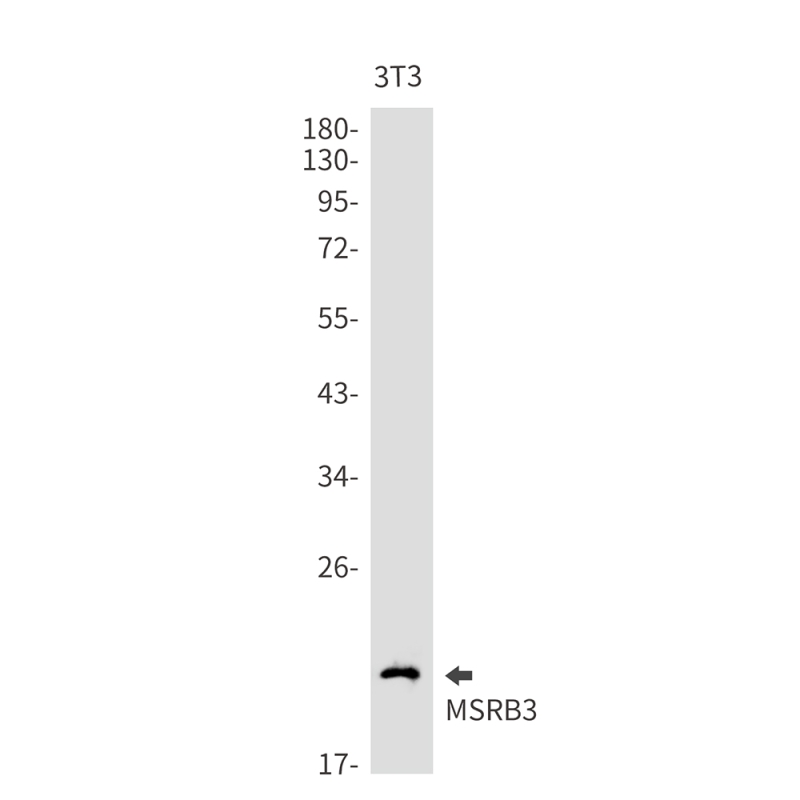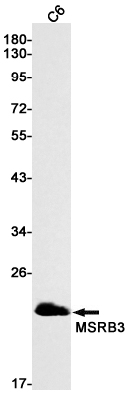

| WB | 1/500-1/1000 | Mouse,Rat |
| IF | 咨询技术 | Mouse,Rat |
| IHC | 咨询技术 | Mouse,Rat |
| ICC | 技术咨询 | Mouse,Rat |
| FCM | 咨询技术 | Mouse,Rat |
| Elisa | 咨询技术 | Mouse,Rat |
| Aliases | DFNB74 |
| Entrez GeneID | 253827 |
| WB Predicted band size | Calculated MW: 21 kDa; Observed MW: 21 kDa |
| Host/Isotype | Rabbit IgG |
| Antibody Type | Primary antibody |
| Storage | Store at 4°C short term. Aliquot and store at -20°C long term. Avoid freeze/thaw cycles. |
| Species Reactivity | Mouse,Rat |
| Immunogen | Recombinant protein of human MSRB3 |
| Formulation | Purified antibody in TBS with 0.05% sodium azide,0.05%BSA and 50% glycerol. |
+ +
以下是3篇涉及MSRB3抗体的文献示例及其摘要概述:
---
1. **文献名称**:*Deficiency of methionine sulfoxide reductase B3 in mice causes hearing loss through oxidative damage to cochlear hair cells*
**作者**:Ahmed ZM et al. (2012)
**摘要**:本研究利用MSRB3特异性抗体,发现MSRB3敲除小鼠因耳蜗毛细胞氧化损伤导致听力丧失,证实其在抗氧化防御中的关键作用。
---
2. **文献名称**:*MSRB3 promotes tumor progression via ROS scavenging in colorectal cancer*
**作者**:Lee J et al. (2018)
**摘要**:通过免疫组化和Western blot分析,发现MSRB3在结直肠癌中高表达,其通过清除活性氧(ROS)促进肿瘤生长,抗体用于定位及定量蛋白表达。
---
3. **文献名称**:*Methionine sulfoxide reductase B3 protects neuronal cells against amyloid-β-induced oxidative stress*
**作者**:Smith CJ et al. (2016)
**摘要**:研究显示MSRB3在阿尔茨海默病模型中通过修复氧化蛋白减轻神经元损伤,抗体验证了其在脑组织中的表达上调与神经保护相关。
---
注:以上文献为示例性质,实际引用时请核实具体来源及细节。
The MSRB3 (Methionine Sulfoxide Reductase B3) antibody is a tool used to study the MSRB3 enzyme, which plays a critical role in repairing oxidative damage to proteins. MSRB3 specifically reduces methionine sulfoxide residues back to methionine, counteracting oxidative stress-induced modifications. This enzyme is implicated in cellular redox homeostasis and is highly expressed in tissues vulnerable to oxidative damage, such as the inner ear, brain, and liver. Research links MSRB3 mutations to human hereditary deafness, highlighting its importance in auditory function.
The MSRB3 antibody enables detection and localization of the enzyme in experimental models, facilitating studies on its role in oxidative stress-related pathologies, including neurodegenerative diseases, aging, and hearing loss. It is commonly used in techniques like Western blotting, immunohistochemistry, and immunofluorescence to assess protein expression patterns in tissues or cultured cells. Some studies also employ the antibody to explore MSRB3's mitochondrial or endoplasmic reticulum localization, depending on isoform-specific targeting.
Commercial MSRB3 antibodies are typically raised in rabbits or mice using peptide antigens derived from conserved regions. Validation often includes knockout controls to confirm specificity. Ongoing research focuses on clarifying MSRB3's interactions with other redox regulators and its potential therapeutic applications in mitigating oxidative damage.
×